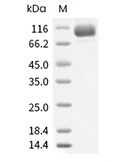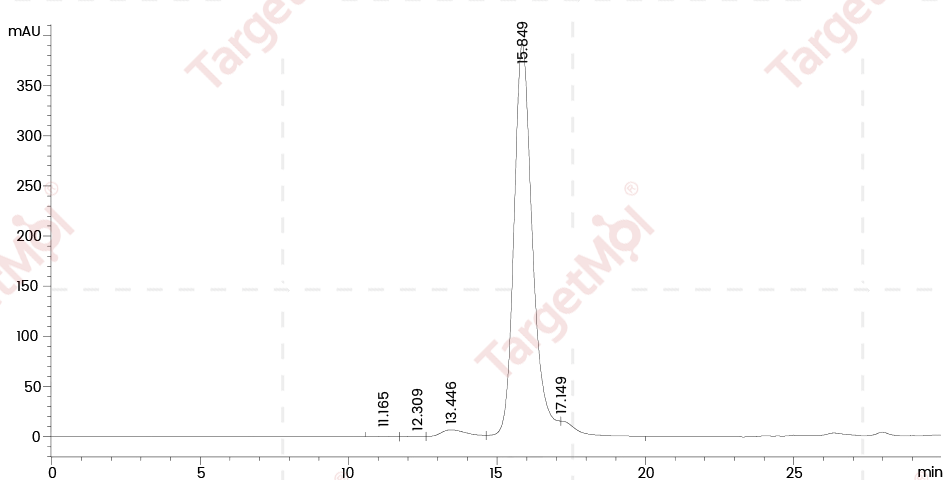Shopping Cart
- Remove All

Your shopping cart is currently empty

| Pack Size | Price | Availability | Quantity |
|---|---|---|---|
| 50 μg | $517 | In Stock | |
| 100 μg | $800 | 7-10 days | |
| 200 μg | $1,240 | 7-10 days | |
| 500 μg | $2,200 | 7-10 days |
| Biological Information | Measured by its ability to convert the substrate benzyloxycarbonyl-Gly-Pro-7-amido-4-methylcoumarin (Z-GP-AMC) to Z-Gly-Pro and 7-amino-4-methylcoumarin (AMC). The specific activity is >1200 pmol/min/μg |
| Description | FAP Protein, Human, Recombinant (His) is expressed in HEK293 mammalian cells with His tag. The predicted molecular weight is 87.2 kDa and the accession number is Q12884-1. |
| Species | Human |
| Expression System | HEK293 Cells |
| Tag | N-His |
| Accession Number | Q12884-1 |
| Synonyms | fibroblast activation protein, alpha,Fibroblast Activation Protein α,SIMP,Fapalpha,Fibroblast Activation Protein alpha,FAPA,fibroblast activation protein, α,DPPIV,DPPIVA,Fapα |
| Construction | The Human FAP (Q12884-1) extracellular domain (Leu26-Asp760) was fused with the polyhistidie tag at the N-terminus. |
| Protein Purity | > 95 % as determined by SDS-PAGE. ≥ 90 % as determined by SEC-HPLC.   |
| Molecular Weight | 87.2 kDa (predicted) |
| Endotoxin | < 1.0 EU/μg of the protein as determined by the LAL method. |
| Formulation | Supplied as sterile 25 mM Tris, 250 mM NaCl, pH 8.2. |
| Reconstitution | A Certificate of Analysis (CoA) containing reconstitution instructions is included with the products. Please refer to the CoA for detailed information. |
| Stability & Storage | It is recommended to store the product under sterile conditions at -20°C to -80°C. Samples are stable for up to 12 months. Please avoid multiple freeze-thaw cycles and store products in aliquots. |
| Shipping | Kinases are highly recommended to be shipped at frozen temperature with blue ice or dry ice. |
| Research Background | Seprase, also known as 17 kDa melanoma membrane-bound gelatinase , Fibroblast activation protein alpha, Integral membrane serine protease and FAP, is a single-pass type II membrane protein which belongs to thepeptidase S9B family. Seprase / FAP is found in cell surface lamellipodia, invadopodia and on shed vesicles. Seprase / FAP appears to act as a proteolytically active 17-kDa dimer, consisting of two 97-kDa subunits. It is a member of the group type II integral serine proteases, which includes dipeptidyl peptidase IV ( DPPIV / CD26 ) and related type II transmembrane prolyl serine peptidases, which exert their mechanisms of action on the cell surface. Seprase / FAP colocalized with DPP4 in invadopodia and lamellipodia of migratory activated endothelial cells in collagenous matrix. Seprase / FAP colocalized with DPP4 on endothelial cells of capillary-like microvessels but not large vessels within invasive breast ductal carcinoma. DPP4 and seprase exhibit multiple functions due to their abilities to form complexes with each other and to interact with other membrane-associated molecules. In association with DPP4, Seprase / FAP is involved in the pericellular proteolysis of the extracellular matrix (ECM), the migration and invasion of endothelial cells into the ECM. Seprase / FAP has a dual function in tumour progression. The proteolytic activity of Seprase has been shown to promote cell invasiveness towards the ECM and also to support tumour growth and proliferation. Seprase / FAP may have a role in tissue remodeling during development and wound healing, and may contribute to invasiveness in malignant cancers.Cancer ImmunotherapyImmune CheckpointImmunotherapyTargeted Therapy |

Copyright © 2015-2024 TargetMol Chemicals Inc. All Rights Reserved.